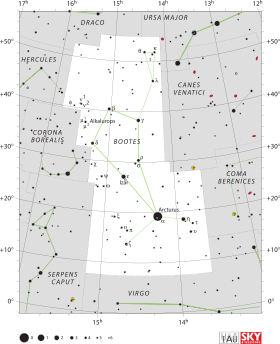Upsilon Boötis
Upsilon Boötis (υ Boötis) is a single,[8] orange-hued star in the northern constellation of Boötes. It is a fourth[2] magnitude star that is visible to the naked eye. Based upon an annual parallax shift of 12.38 mas as seen from the Earth,[1] it is located about 263 light years from the Sun. The star is moving closer to the Sun with a radial velocity of −6 km/s.[4]
 | |
| Observation data Epoch J2000.0 Equinox J2000.0 (ICRS) | |
|---|---|
| Constellation | Boötes |
| Right ascension | 13h 49m 28.64078s[1] |
| Declination | +15° 47′ 52.4603″[1] |
| Apparent magnitude (V) | 4.023[2] |
| Characteristics | |
| Spectral type | K5.5 III[3] |
| U−B color index | +1.893[2] |
| B−V color index | +1.518[2] |
| Astrometry | |
| Radial velocity (Rv) | −5.94±0.26[4] km/s |
| Proper motion (μ) | RA: −94.22±0.19[1] mas/yr Dec.: +41.07±0.14[1] mas/yr |
| Parallax (π) | 12.38 ± 0.23[1] mas |
| Distance | 263 ± 5 ly (81 ± 2 pc) |
| Absolute bolometric magnitude (Mbol) | −1.44±0.14[5] |
| Details | |
| Mass | 1.11±0.33[6] M☉ |
| Radius | 38.44±2.37[5] R☉ |
| Luminosity | 332±54[6] L☉ |
| Surface gravity (log g) | 1.5[4] cgs |
| Temperature | 3,920[6] K |
| Metallicity [Fe/H] | −0.23[4] dex |
| Rotational velocity (v sin i) | 5.1[4] km/s |
| Other designations | |
| Database references | |
| SIMBAD | data |
This is an evolved K-type giant star with a stellar classification of K5.5 III.[3] Astroseismology was used to obtain a mass estimate of 1.11 times the mass of the Sun,[6] while interferometric measurements give a size of about 38[5] times the Sun's radius. It is radiating about 332[6] times the Sun's luminosity from its enlarged photosphere at an effective temperature of 3,920 K.[6]
References
- van Leeuwen, F. (2007), "Validation of the new Hipparcos reduction", Astronomy and Astrophysics, 474 (2): 653–664, arXiv:0708.1752, Bibcode:2007A&A...474..653V, doi:10.1051/0004-6361:20078357.
- Gutierrez-Moreno, Adelina; et al. (1966), A System of photometric standards, 1, Publicaciones Universidad de Chile, Department de Astronomy, pp. 1–17, Bibcode:1966PDAUC...1....1G.
- Keenan, Philip C.; McNeil, Raymond C. (1989), "The Perkins catalog of revised MK types for the cooler stars", Astrophysical Journal Supplement Series, 71: 245, Bibcode:1989ApJS...71..245K, doi:10.1086/191373.
- Massarotti, Alessandro; et al. (January 2008), "Rotational and Radial Velocities for a Sample of 761 HIPPARCOS Giants and the Role of Binarity", The Astronomical Journal, 135 (1): 209–231, Bibcode:2008AJ....135..209M, doi:10.1088/0004-6256/135/1/209.
- Piau, L.; et al. (2010), "Surface convection and red giants radii measurements", Astronomy and Astrophysics, 526: 12, arXiv:1010.3649, Bibcode:2011A&A...526A.100P, doi:10.1051/0004-6361/201014442, A100.
- Stello, D.; et al. (2008), "Oscillating K Giants with the WIRE Satellite: Determination of Their Asteroseismic Masses", The Astrophysical Journal Letters, 674 (1): L53–L56, arXiv:0801.2155, Bibcode:2008ApJ...674L..53S, doi:10.1086/528936.
- "ups Boo". SIMBAD. Centre de données astronomiques de Strasbourg. Retrieved 2017-09-09.
- Eggleton, P. P.; Tokovinin, A. A. (September 2008), "A catalogue of multiplicity among bright stellar systems", Monthly Notices of the Royal Astronomical Society, 389 (2): 869–879, arXiv:0806.2878, Bibcode:2008MNRAS.389..869E, doi:10.1111/j.1365-2966.2008.13596.x.